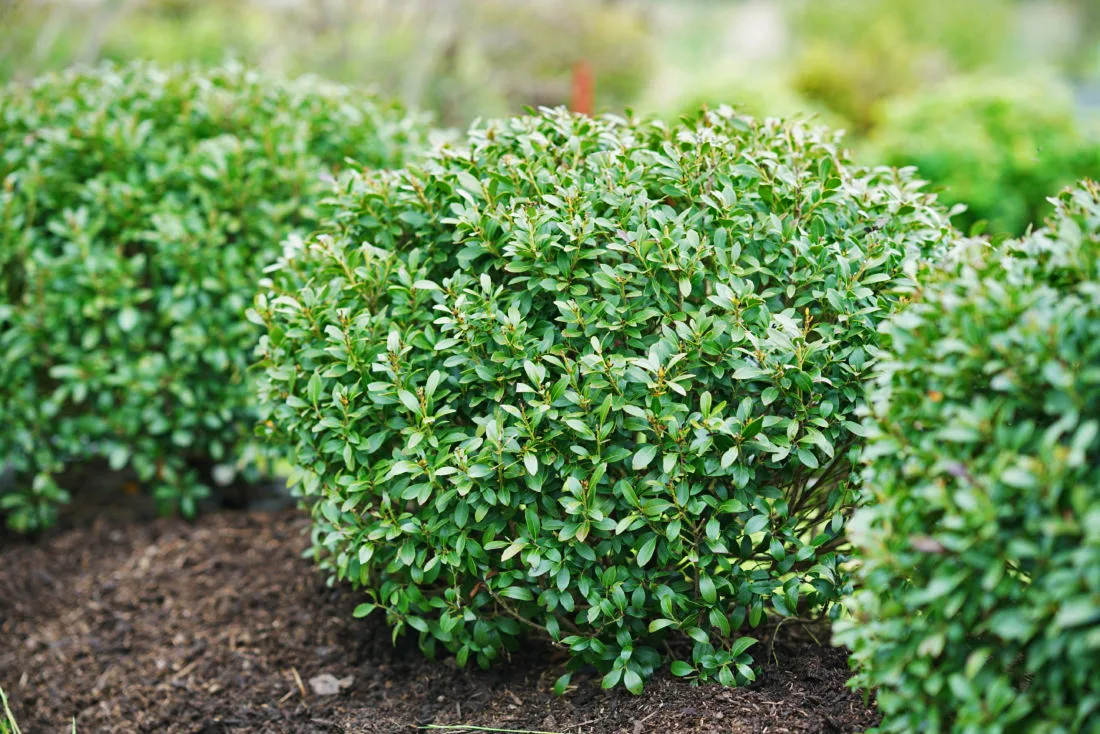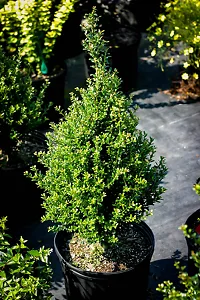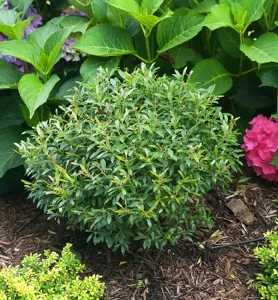
Written by s • The Perfect Substitute for Boxwood – New Hollies
Boxwood is definitely one of the most iconic garden plants there is. Most people recognize it straight away, and those clipped hedges are a symbol of the organize, formal look for gardens. Start growing it yourself and even in areas where it often grows well, problems start to develop. When the early settlers arrived with their precious baby plants, ready to re-create their European gardens in the New World, they hadn’t counted on the incredible range of climates in their new homeland. From the intense winter cold in the north, to the long humid and hot summers of the south, both climate and soil presented challenges to boxwoods that European plant had never encountered before. More recently, here and back in Europe, new pests and diseases have begun to attack these plants, so growing them can often be a challenge.
Ready to give up? Well don’t – or rather, go ahead and give up on boxwood, but don’t give up on evergreen shrubs with tiny, glossy green leaves, that clip well into balls, cones, and neat hedges. I’d like to introduce you to two plants that are perfect – depending on your soil and climate – as substitutes that will even fool that expert gardener who lives down the street (every neighborhood has one).
Even the Experts are Changing
When you do change to these new plants, you will be in good company. Large gardens are also replacing their boxwood with something else. Het Loo Palace is a famous restored 17th century garden with miles (literally) of ornate clipped boxwood hedges in the Dutch and French style. Back in 2013 they replaced all that boxwood, badly damaged by disease, with another shrub that looks virtually identical, but grows without any problems. What was it? Holly.
Replacing Boxwood with Special Hollies
Holly? That’s right, but not the Christmas card holly we all love, with its bright red berries and spiny leaves. There are two types of holly that are being used to replace boxwood, depending on your location and soil conditions. At Het Loo Palace they used a compact form of the Japanese Holly, Ilex crenata. In hot southern states, and in wet soils, there are new varieties of an American bush, the Inkberry, Ilex glabra, that are perfect for that boxwood look, but that thrive instead of struggle. Let’s take a look at them.
Dwarf Japanese Holly
This bush, called Ilex crenata by the experts, comes not just from Japan, but also from China, Korea and eastern Russia. In the wild it usually forms a small tree, and the ends of the leaves have small notches, but garden plants are much smaller, and the leaves are rounded, looking exactly like boxwood. (If you really want to impress, look at the leaves on the stems. In true boxwood they are in opposite pairs, but in holly they alternate along the stem.) One of the most well-known is the Sky Pencil Holly, which is one of the most popular evergreens for slender, upright accent plants or slim hedges. But as well as upright plants there are several forms – we especially love the one called ‘Convexa’ – it makes dense, rounded bushes and is perfect for clipping into hedges or balls.

These Japanese holly bushes are very easy to grow. They are hardy in zone 6, and all they way into the heat of zone 9. If you live in colder zones you will probably find that the true boxwood (Buxus) grows well for you, so you won’t need a substitute, and you have many varieties to choose from. In hotter areas, Japanese holly is so much easier to grow. It enjoys the heat and thrives in almost any type of soil. It does prefer slightly acidic soils, but adding some organic material to the soil, and as mulch, will let it grow well in all but strongly alkaline soils. It is happy in town gardens, and the only thing it doesn’t like are ‘wet feet’. It won’t grow well in wet, badly drained soil (but read on for help with that. . .) It grows in both full sun and partial shade, and has the same handsome small, glossy leaves we love. It clips just as well as any boxwood, and forms hedges quickly. Forget about pests or diseases, this tough plant will change your life, and you will soon wonder what you were doing struggling with boxwood, when you could be relaxing with the Convexa or Patti O Box™ Japanese Holly bushes.
Meet the Inkberry
The Civil War soldiers had a hard life, in very difficult conditions, but they sill managed to write home to their family and loved ones. The only ink they had was what they made themselves, from a native bush they called Inkberry. The name stuck for a unique holly bush called Ilex glabra. Wild plants grow all the way up to Nova Scotia, but they are much more common in the South, from Florida to Louisiana. The wild bush is around 6 feet tall, with an open form, but breeding has given us some great compact plants that are the perfect choice if you garden in the hottest zones, and you have wet soil, so that Japanese holly won’t grow well.

Inkberry holly will grow in zone 6, but it is most valuable in the hottest zones – 8, 9 and 10. There most boxwood almost never thrive, so forget it and go straight for these terrific bushes. The only limitation is their love of water, so don’t plant them in dry places. If you have wet spots they will grow well, and in regular soil water regularly. You won’t see pests or diseases on them, and they grow faster than boxwood too. It is also more sensitive to alkaline soils, but southern soils are acidic anyway, so this is unlikely to be an issue. In planters choose a soil for acid-loving plants.
Don’t struggle to grow conventional boxwood, make the change and make your life easy, with these great substitutes that have the look, but without the trouble.
***If you want to check the availability of any of the plants mentioned here, go to our Home Page, click on the ‘Search’ button in the upper right, and type in your choice – both common names and botanical ones will work. If, sadly, you find the item sold out, click on the ‘notify me’ box beside the size you want, and you will get an email the moment that plant is available again – it’s easy.





